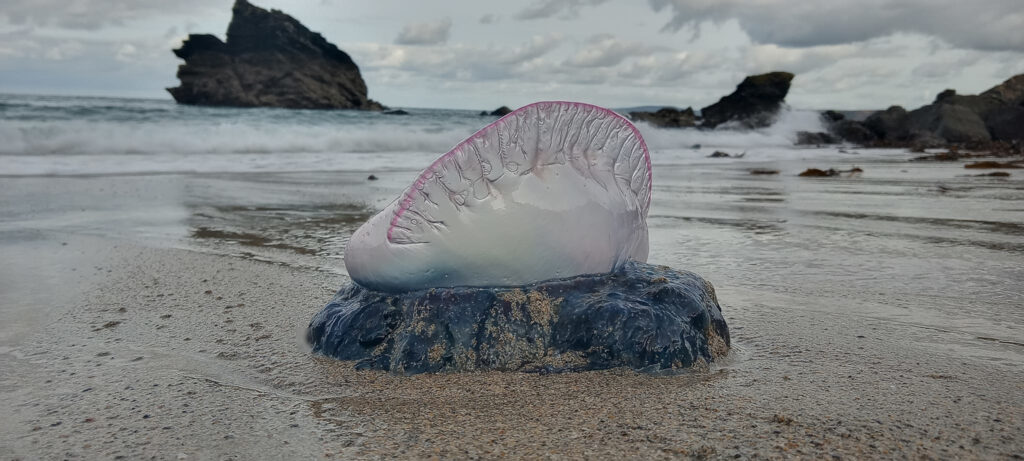A SCOT has shared the incredible snap he took of a bizarre marine creature that had washed up on the sands of a UK beach.
Iain Davidson had been taking a dip in the sea by Northcott, Cornwall on Sunday, when he noticed a curious creature bobbing in the water near him.

Keeping his distance, the 63-year-old returned to shore only for the creature to wash up on the beach just 15 minutes later.
Former lighting director Iain managed to get a closer look at the marine animal, where he was able to identify it as a Portuguese man o’ war – a relative of the jellyfish, non-native to the UK.
Iain’s incredible image shows a curious pale pink fin sitting atop a grey rock-like structure on the wet sands of the beach.
However, upon closer inspection, the ‘rock’ is actually the lower anatomy of the man o’ war, which appears to be connected to a string of dangerous tentacles.
Waves can be seen lashing against rocks from behind the man o’ war, which unfortunately seems to be dead upon washing onto the shore.
Iain took to social media on Sunday to share the incredible find, writing: “Spotted this while swimming today, kept my distance until it reached the shoreline. Portuguese man o’ war.
“Technically not jellyfish but the tentacles can give a nasty sting even when dead.”
The post received over 4,500 likes and more than 740 comments from users left bemused by the strange appearance of the man o’ war.
The body of the jellyfish-like creature appears translucent with waves of light rainbow colours across its float bubble, making for a truly bizarre appearance.
Gill Sims wrote: “Be wary of them. As a child, I was hospitalised after being stung by a Portuguese man o’ war.”
Dina Filoulou Froude said: “You could have knocked me over with a feather when I read that was not a rock it’s sat on, it’s tentacles.”
Kim Knapper commented: “We spotted one at Longrock. They are very dangerous – you have to ring the coastguard to have it removed. If it stings a dog, its fatal.”
Robin Leath added: “Hope it was quite a distance as tentacles can reach up to and over 30m (that’s 100ft plus some) on some larger specimens.”
Speaking to Iain today, he said: “I’m a cold-water swimmer and I was having a dip in my favourite Cove on the Northcott of Cornwall when I spotted the float part of the Portuguese Man of War (PMoW) bobbing in the water a few feet away.

“I know the reputation they have for stinging, so swam clear. I don’t wear a wetsuit so I didn’t want to risk being stung in deep water.
“The wind and tide pushed the PMoW to the shore and I got my camera out to record the beauty of the creature.
“This was the first one I’ve seen in the water, but they do get washed up occasionally. I’m amazed how much interest has been generated.
“Jellyfish are always a concern for sea swimmers, but most stings are no worse than that of a nettle.
“The PMoW is in another league and seems to generate a bit more fear but maybe that’s unjustified.
“I just don’t want to experience it for myself. It’s the tendrils that hang below the float that sting, even after it’s died, so care is required even on the shore.”
The Portuguese man o’ war is a marine hydrozoan usually found in the Atlantic Ocean and the Indian Ocean.
Although it resembles a jellyfish, it is in fact a siphonophore, meaning it is a colonial organism, made up of many smaller units called zooids.
All zooids in a colony are genetically identical, but fulfill specialized functions such as feeding and reproduction, and allow the colony to operate as a single individual.
The man o’ war has numerous tentacles that can deliver a painful sting powerful enough to kill fish, and has been known to occasionally kill humans.

